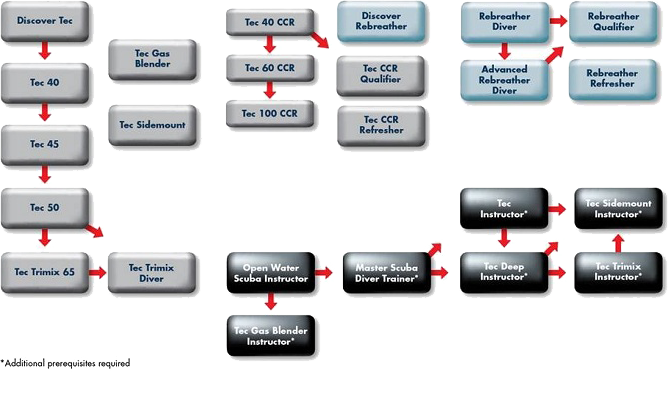You have 0 product(s) in your cart.
The Path To Technical Diving
Learn about technical diving and get to try it out.
Technical diving is scuba diving’s “extreme” sport, taking experienced and qualified divers far deeper than in mainstream recreational diving. Technical diving is marked by significantly more equipment and training requirements to manage the additional hazard this type of diving entails. Tech diving isn’t for everyone, but for those who hear its challenge call, the PADI TecRec courses are the answer.
Get certified in highly recommended tech diving courses as per your diving certifications. Check the appropriate course for you as per the tech diving course map.

Technical Diving Courses
What is technical diving?
Technical scuba diving is defined as diving other than conventional commercial or research diving that takes divers beyond recreational scuba diving limits. It is further defined as and includes one or more of the following:
- diving beyond 40 metres
- required stage decompression
- diving in an overhead environment beyond 40 linear meters from the surface
- accelerated decompression and or the use of variable gas mixtures during the dive
Because in tech diving the surface is effectively inaccessible in an emergency, tec divers use extensive methodologies and technologies and training to manage the added risks. Even with these, however, tec diving admittedly has more risk, potential hazard and shorter critical error chains than recreational diving.
How long has technical diving been around?
Most people would agree that cave diving is a form of tech diving. Cave diving developed in the late 1960s and 1970s, developing into a discipline largely like it is today by the mid-1980s. In the early 1990s, several groups of divers around the world began experimenting with technologies for deep diving (beyond recreational limits) to explore both caves and wrecks. These communities united and emerged as “tech diving” or “tech diving” with the publication of aquaCorps (no longer in print), which dedicated itself to this type of diving. Since then, tec diving continues to develop both in scope and in its technologies.
Why would I want to be a tec diver?
Tech diving not only has more risk, but it requires significantly more effort, discipline and equipment. It’s not for everyone, and you can be an accomplished, avid top-notch diver your entire life without making a tec dive.
That said, there’s a cadre of individuals who want to visit places underwater that relatively few people can. Many spectacular, untouched wrecks lie at depths well below 40 metres/130 feet. Deep reefs have organisms you don’t find in the shallows. Some people enjoy the challenge and focus tech diving requires. Still, others love being involved with cutting-edge technologies. These reasons make tech diving rewarding.
The PADI TecRec Difference
The TecRec program debuted in 2000. Although TecRec is not the first tec diving program (cave diver training has been around for decades), it repeatedly receives accolades for its merits.
- TecRec courses are integrated into an instructionally valid, seamless course flow that takes you from beginning tec diver to one qualified to the outer reaches of sport diving using different gas mixes.
- Each level introduces you to new gear, planning and procedures appropriate to extend your diving limits.
- The Tec Diver course is an integrated sequence of three subcourses: Tec 40, Tec 45 and Tec 50. You can complete them continuously, or you can complete each level separately with a time span between them. This gives you learning efficiency, instructional integrity and schedule flexibility.
The Scuba Gear You'll Use
Tec diving uses much more equipment than recreational diving. The technical scuba gear typically uses two to four or five regulators, a dive computer, and some accessories.
Check with us about the gear you need for this course.
Prerequisites
TecRec prerequisites vary (see individual course descriptions), but the following applies to anyone interested in tecl diving. You must be
- 18 years or older
- A mature, responsible person who will follow the required procedures and requirements strictly and faithfully
- Medically fit for tec diving (physician’s signature required)
- Willing to accept the added risks that tec diving presents
- An experienced diver with at least 30 logged dives
- Certified as a PADI Enriched Air Diver and PADI Deep Diver or equivalent (for this program equivalency is proof of training in recreational deep diving 18 meters/60 feet to 40 meters/130 feet consisting of at least four dives and training in nitrogen narcosis considerations, contingency/emergency decompression, making safety stops and air supply management OR, have a minimum of 20 logged dives deeper than 30 meters.)